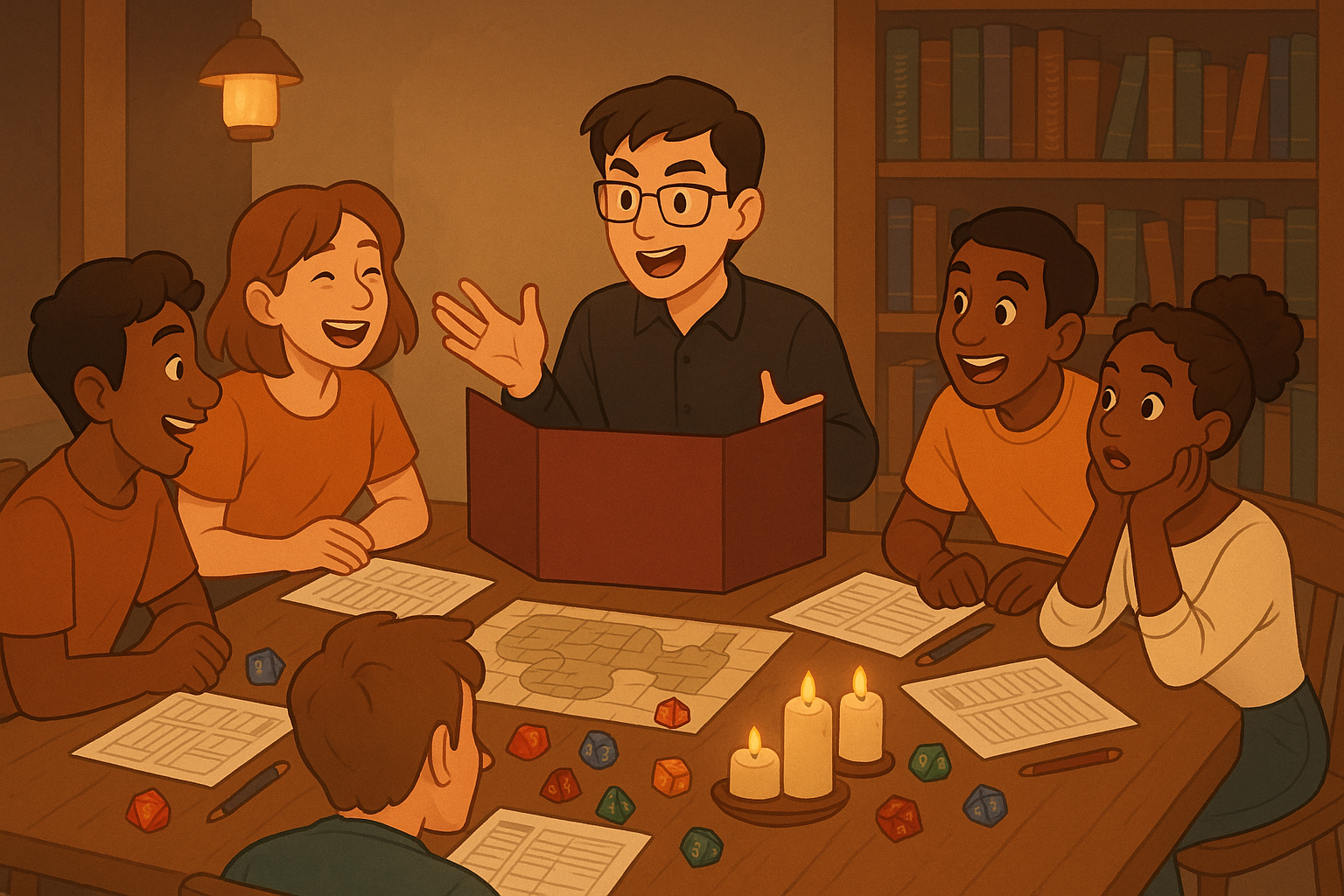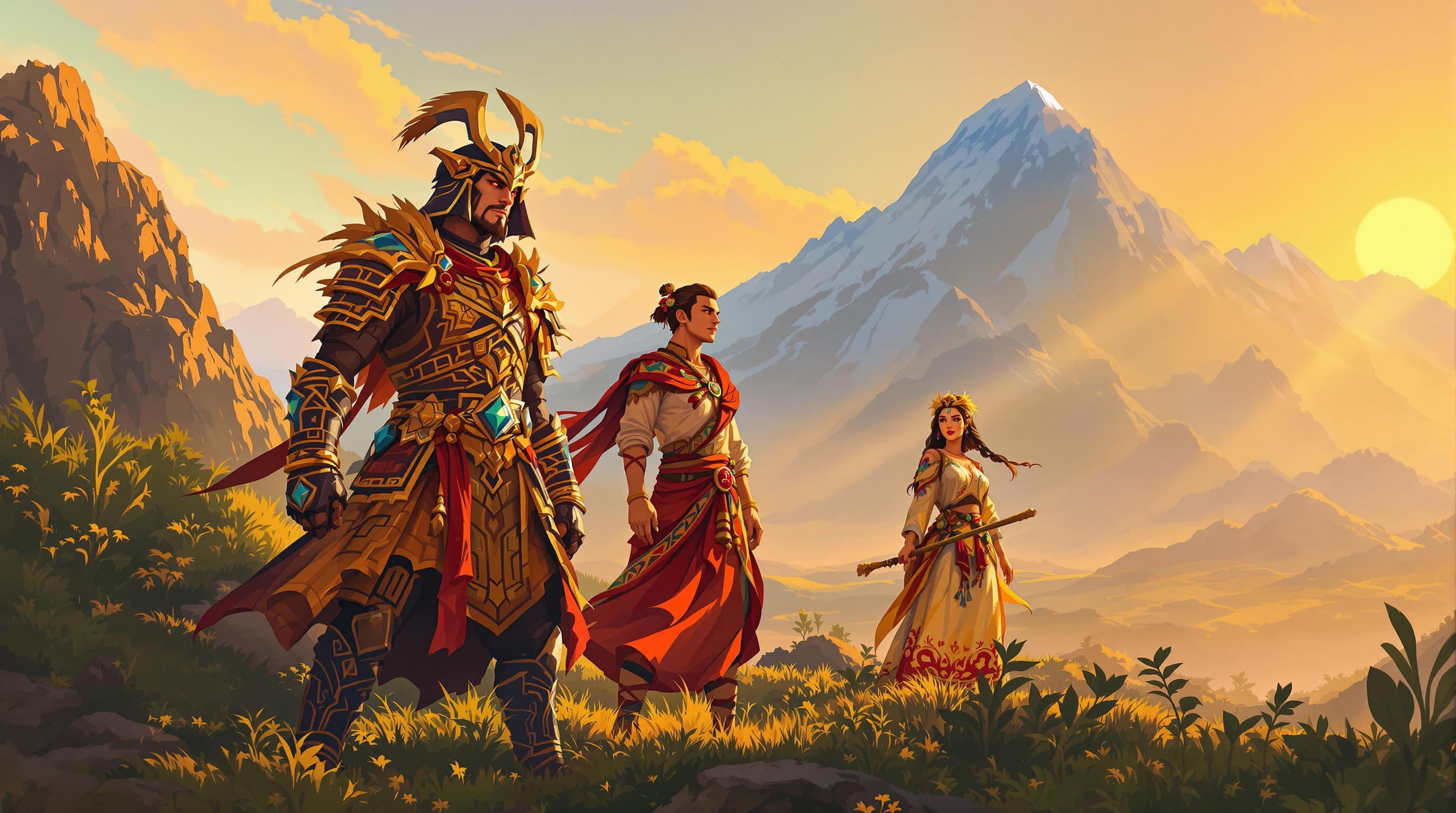Narrative mechanics in RPGs connect gameplay to storytelling, empowering players and Game Masters (GMs) to create dynamic, immersive stories. These mechanics include tools like character-driven story points, GM pacing systems, and collaborative storytelling rules. Here's what you need to know:
- Player Control: Systems like Fate Points or Beliefs let players shape the story through their character’s traits and decisions.
- GM Tools: Features like Countdown Clocks or GM Moves help structure and balance the narrative.
- Shared Storytelling: Games like Microscope or Fiasco encourage collaborative world-building and scene creation.
Lessons for Narrative Design from Modern Tabletop RPGs
Main Types of Story-Driving Mechanics
Story-driving mechanics in RPGs fall into three main categories, each playing a distinct role in shaping narratives. Here's a breakdown of how these mechanics contribute to storytelling.
Player Story Control Systems
These mechanics let players take charge of the narrative. They usually involve spending points or using character-specific resources to influence the story. For instance, Fate Points in Fate Core allow players to introduce story elements or activate character traits, while the Beliefs system in Burning Wheel rewards players for pursuing their character's personal goals and motivations.
Key traits of these systems include:
- Story elements driven by characters
- Resource use to shift narrative direction
- Incentives for contributing to the story
- Connections between character traits and plot progression
GM Story Tools
Game Masters rely on specific tools to guide and manage narratives while keeping gameplay balanced. For example, Apocalypse World uses GM Moves to provide structured responses to player actions, ensuring the story progresses smoothly. Similarly, Blades in the Dark features Clocks, visual trackers that help GMs manage complex situations and build suspense.
These tools often include:
- Systems for framing scenes and escalating conflicts
- Frameworks for NPC interactions
- Guidelines for pacing the story effectively
Shared Storytelling Rules
These mechanics encourage collaborative storytelling among all participants. Microscope, for example, uses Period and Event cards to let players collectively build the game’s history. Meanwhile, Fiasco features Scene Selection, where players alternate between setting up and resolving scenes.
Common elements of shared storytelling rules include:
- Turn-based control of the narrative
- Tools for reaching group consensus
- Structured phases for story creation
- Equal opportunities for all players to contribute
When used well, these mechanics blend rules and storytelling seamlessly, creating a richer gaming experience.
Benefits of Story-Focused Game Rules
Connecting Rules to Story
Story-driven mechanics link player actions directly to the narrative, giving every choice weight. For example, the Bonds system in Dungeon World rewards players with experience points when they act based on their relationships with other characters.
In Burning Wheel, the Practice system ties character growth to story events, encouraging a variety of narrative opportunities. This close connection between rules and storytelling creates a foundation for dynamic and evolving plotlines.
Building Varied Stories
These mechanics also encourage diverse storytelling. Instead of sticking to rigid storylines, they provide flexible frameworks for organic development. In Blades in the Dark, the Engagement Roll determines how heists begin, setting up unique starting points that lead to distinct story arcs.
Narrative rules also keep the tension alive. The Countdown Clock, featured in Powered by the Apocalypse games, introduces escalating challenges that demand player action. This mix of structure and freedom ensures stories remain unpredictable yet satisfying.
Supporting Player Input
Story-focused rules give all players tools to shape the narrative. In Fate Core, the Compel system lets players suggest plot twists in exchange for Fate Points, making them active participants in crafting the story.
Games like Ironsworn use prompts and oracle tables to help players generate plot elements, making collaborative storytelling easier. The game’s Progress Tracks offer a way to measure story advancement while keeping the narrative adaptable.
These mechanics encourage collaboration between players and GMs, resulting in rich, evolving stories that feel natural and player-driven.
sbb-itb-b8b00a5
Using Narrative Mechanics Effectively
Player Guide: Story Mechanics
To get the most out of story mechanics, focus on your character's narrative tools. Take time to understand how these tools work - like Aspects in Fate Core or Bonds in Dungeon World. These aren't just background details; they’re tools to shape the story and drive it forward.
Be strategic with resources like story points. Save them for high-stakes moments. For example, in 7th Sea, managing Hero Points carefully allows players to create more dramatic and impactful scenes during climaxes.
Use your character's backstory during gameplay. If your character has a trait like Haunted Past, find moments to bring those memories into the current story. This not only adds depth to your character but also gives Game Masters (GMs) new story hooks to explore.
Collaborating with other players on narrative tools can make the story even richer. In Blades in the Dark, combining Flashbacks from multiple crew members can lead to layered, dynamic scenes that enhance the group’s shared experience.
GM Guide: Story Management
While players shape the narrative through mechanics, GMs need to adapt and integrate these contributions smoothly. Start each session by reviewing story mechanics and identifying key moments where they might come into play. This helps you weave narrative triggers into the game naturally.
Encourage a responsive environment for player-driven storytelling. When players use mechanics like Fate Points to add story details, embrace those ideas and incorporate them into future events. This shows players their choices matter and helps build a more immersive world.
Pacing is another area where mechanics can help. Systems like Apocalypse World's Countdown Clocks are great for creating tension. Use multiple clocks for different threats, advancing them based on player actions and the flow of the story.
Here are some practical tips for handling specific story mechanics:
-
Character Bonds
- Encourage players to use bonds during pivotal scenes.
- Design scenarios that test or deepen relationships.
- Reward meaningful interactions tied to bonds with extra experience.
-
Story Points
- Keep track of how points are used to maintain game balance.
- Offer chances for players to earn points through engaging roleplay.
- Pay attention to how players spend points - it can reveal what parts of the story they’re most invested in.
Finding Story-Rich RPGs
To dive deeper into narrative-focused gameplay, it's important to know how to pinpoint RPGs that prioritize storytelling. By understanding the mechanics behind these games, you can select ones that enhance both player and GM storytelling experiences.
Tips for Searching the TTRPG Games Directory
Focus on games that highlight narrative-driven features. Look for these key elements in game descriptions:
-
Narrative Control Systems
- How players can shape the story
- Tools for collaborative storytelling
- Systems for framing and resolving scenes
- Plot progression tied to characters
-
Mechanical Elements
- Use of story points or narrative currency
- Rules that emphasize character bonds and relationships
- Mechanics for introducing plot twists
- Character progression linked to the story
-
Storytelling Support
- Resources for building immersive worlds
- Tools for managing dramatic tension
- Systems that reflect the impact of player choices
- Group-focused storytelling frameworks
When evaluating games, consider how the mechanics influence storytelling. Think about your group's preferences, such as:
- How much control players vs. the GM have over the story
- The complexity of the game rules
- The style of character progression
- How scenes are resolved
Well-designed narrative mechanics can elevate the storytelling experience. Use the directory's detailed descriptions to find games that align with the type of stories your group wants to create.
Conclusion: Story Mechanics in Practice
Narrative mechanics connect game rules with engaging RPG storytelling. When used effectively, they allow players and GMs to create dynamic stories within a structured system.
The key is finding the right balance between structure and creativity. Whether it's using story points to guide the plot or relationship mechanics to develop deeper character bonds, these elements should blend naturally into gameplay.
Here are some tips to integrate mechanics and storytelling effectively:
- Start Small: Introduce just one or two mechanics at first to avoid overwhelming the group.
- Stay Flexible: Adjust rules to fit your group's unique storytelling style.
- Prioritize Impact: Pick mechanics that genuinely influence the story.
- Collaborate: Use tools and discussions to ensure everyone has a voice in shaping the narrative.
This approach turns gameplay into a rich storytelling experience. As you explore RPGs and their narrative systems, focus on mechanics that align with your group's style. The right mix of rules and creative freedom can elevate regular gaming sessions into unforgettable stories that keep players engaged and excited for what's next.


